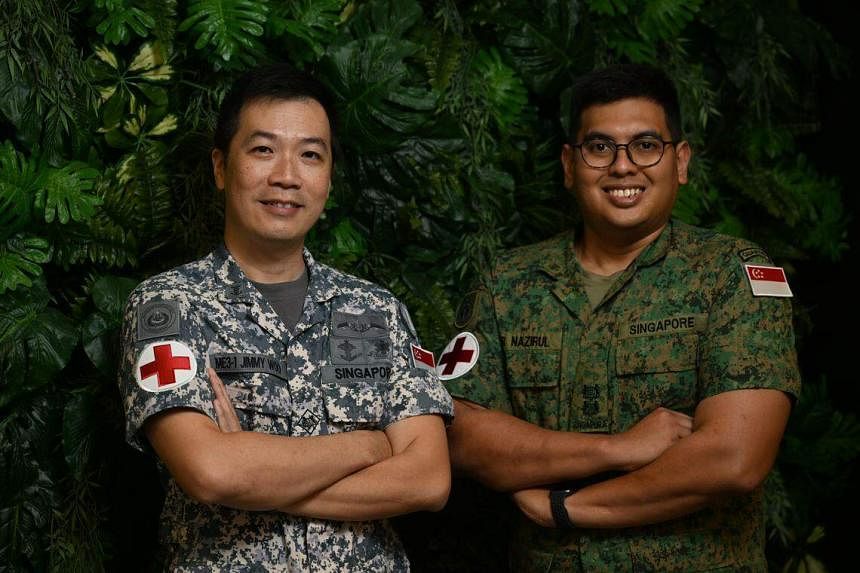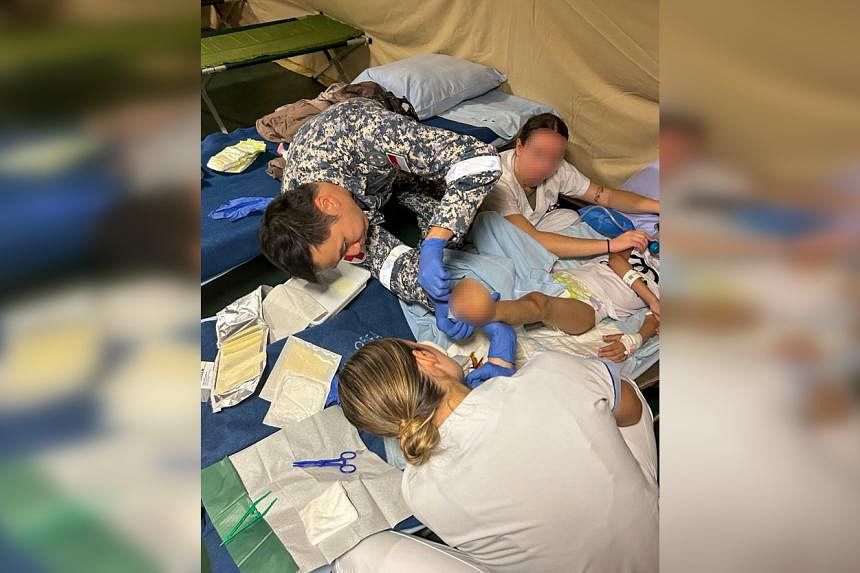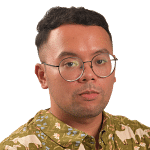SINGAPORE – The sight of a malnourished six-year-old girl with an amputated left foot who was screaming in pain immediately made Lieutenant-Colonel (Dr) Nazirul Hannan Abdul Aziz think of his two young sons back home.
The patient, who was on board a hospital ship in Egypt, was barely two years older than his eldest son, and treating her left a mark on him.
Her stump was infected, but she refused to let the medical personnel touch her and eventually had to be sedated, he recounted.
“She was very terrified. There was a lot of terror in her eyes, and you could see the trauma,” said LTC (Dr) Nazirul.
She was among those who had made it out of Gaza when Israel bombarded it in retaliation for the Oct 7 attacks by Hamas. She was also one of the most memorable patients that LTC (Dr) Nazirul and Military Expert 3 Jimmy Woo treated during their nine-day deployment on board the French Armed Forces’ FS Dixmude, a navy ship with modern hospital facilities.
Gaza’s health ministry said on Feb 21 that the death toll across the Palestinian strip had climbed to 29,313 people, with 69,333 injured since the start of the war.
The majority of the patients the two men saw in Egypt were civilians – most of them children and young adults.
Their youth was a marked difference from those of previous overseas deployments, said the 35-year-old LTC (Dr) Nazirul, who was based out of the ship berthed at El Arish port with ME3 Woo. The French Armed Forces had invited the Singapore Armed Forces (SAF) to provide two medical personnel to serve on board.
El Arish port is located in the north-eastern part of Egypt. The city of El Arish is roughly 50km away from the Rafah crossing, which is the main gateway to Gaza from Egypt.
The SAF’s participation in this humanitarian mission had been at the invitation of the French, with Minister for Defence Ng Eng Hen saying in a written parliamentary reply on Feb 5 that the SAF will continue to monitor the situation in the region closely and assess how it can contribute further in this aspect.
The two-man medical team arrived on Jan 18 and immediately started tending to patients, being tasked with the initial stages of treatment.
LTC (Dr) Nazirul, a specialist in emergency medicine, and ME3 Woo, who specialises as an operating theatre scrub nurse and in the care of surgical patients, would triage patients and treat them immediately before they were sent to other parts of the ship for further medical treatment.
The ship’s rooms were retrofitted with medical equipment and converted into operating theatres and an intensive care unit, while patient wards made out of military tentage were set up in the ship’s hangar.
Unlike a typical hospital on land, running a hospital ship required much more planning.
While it has the same resources as any ordinary hospital, the crew had to ensure that they stored sufficient supplies while also contending with space limitations.
ME3 Woo, who previously went to Afghanistan to provide medical aid in 2009, said: “On a land-based hospital, you can have all the specialists, logistics and resources on the ground.
“On ships, you need to pre-plan as much as possible, and the French did well. It was a very well-planned deployment,” he said, adding that there was no shortage of medical supplies.

A hurdle they had to overcome was the language barrier. The working language on the ship was French, while patients spoke mostly only Arabic, both languages that neither man knew.
“Some of the patients did speak English, but I feel that as a foreigner, if you could speak a little bit of their language… you bring more comfort to them,” said ME3 Woo.
He added that they picked up some Arabic from translators on board, but also used gestures to communicate, mimicking wound dressing, for example. Also, English-speaking doctors on board helped to translate French for the pair.
Throughout their time there, they were able to update their families daily using a local telephone line.
Their loved ones were their first priority when they returned to Singapore on Jan 28, with ME3 Woo taking his family out for a meal at a hawker centre.
LTC (Dr) Nazirul, meanwhile, spent time with his two sons, aged four and two, and “hugged them a lot tighter”.
He said: “What we saw was very real. It was very different from seeing it many, many miles away, but treating these people, seeing how alike we were, was very real.
“In this day and age, there are people who are suffering in such circumstances. We, in Singapore, have been very used to peace, but we cannot take that for granted.”
Besides spending time with his children, LTC (Dr) Nazirul said he taught them something he had learnt from the Palestinian patients.
“No matter what brings you down, there is always light at the end of the tunnel,” he said, citing the Gazans’ strong spirit amid the circumstances, even as some had lost limbs.
“It was the spirit that, despite all these circumstances they had to undergo, they could still smile, and they were very positive.
“It showed me… the emotional and mental resilience of these people, and it’s something I really admire.”


